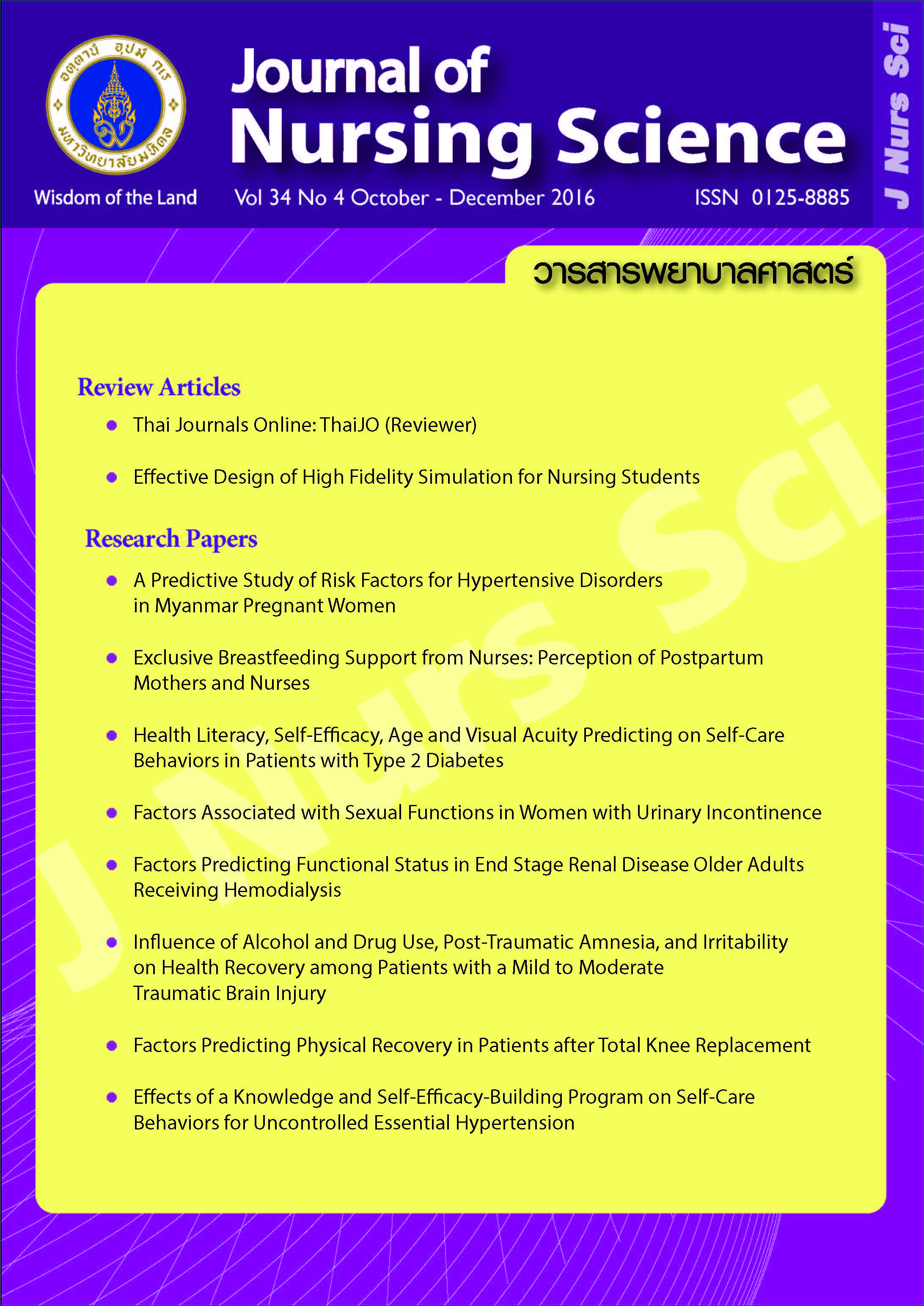A Predictive Study of Risk Factors for Hypertensive Disorders in Myanmar Pregnant Women
Main Article Content
Abstract
Abstract
Purposes: To identify age, parity, pre-pregnancy body mass index (BMI), family history of hypertension, and gestational diabetes mellitus (GDM) as the predictive factors for hypertensive disorders in Myanmar pregnant women.
Design: A predictive design.
Methods: The sample consisted of 388 pregnant women who attended the antenatal clinic of two tertiary teaching hospitals in Yangon, Myanmar. Study factors and personal data were collected with questionnaire. Data were analyzed by descriptive statistics, chi-square test, fisher’s exact test and binary logistic regression analysis.
Main findings: Parity, pre-pregnancy BMI, family history of hypertension, and GDM were significantly accounted for 56.1% of variance to predict hypertensive disorders in Myanmar pregnant women. Primiparous women had 2.6 times higher risk of hypertensive disorders than those multiparous women (95%CI 1.1-5.9, p < .05). Women who had pre-pregnancy BMI ≥ 23 kg/m2 had 14.8 times higher risk of hypertensive disorder than those who had pre-pregnancy BMI < 23 kg/m2 (95%CI 3.4-65.2, p < .05). Pregnant women who had family history of hypertension had 3.3 times higher risk of hypertensive disorder than those who no family history of hypertension (95%CI 1.4-8.0, p < .05). Pregnant women who diagnosed with GDM had 24.6 times higher risk of
hypertensive disorder than those who no GDM (95%CI 8.4-72.5, p < .05).
Conclusion and recommendations: Screening and monitoring risk factors of hypertensive disorders such as parity, pre-pregnancy BMI ≥ 23 kg/m2 , family history of hypertension and GDM, should be concerned. Pregnant women who are at risk of hypertensive disorders should be advised to change their lifestyle to control pre-pregnancy body weight.
การศึกษาปัจจัยเสี่ยงต่อการทำนายการเกิดภาวะความดันโลหิตสูงขณะตั้งครรภ์ในสตรีตั้งครรภ์ชาวพม่า*
บทคัดย่อ
วัตถุประสงค์: ศึกษาอำนาจการทำนายของอายุ จำนวนครั้งของการคลอด ดัชนีมวลกายก่อนการตั้งครรภ์ ประวัติโรคความดันโลหิตสูงในครอบครัว และภาวะเบาหวานในขณะตั้งครรภ์ ต่อการเกิดภาวะความดันโลหิตสูงขณะตั้งครรภ์ในสตรีตั้งครรภ์ชาวพม่า
รูปแบบการวิจัย: การศึกษาเชิงทำนาย
วิธีดำเนินการวิจัย: กลุ่มตัวอย่างเป็นสตรีตั้งครรภ์ จำนวน 388 รายที่มาฝากครรภ์ที่โรงพยาบาลระดับตติยภูมิจำนวน 2 แห่งในกรุงย่างกุ้ง ประเทศพม่า เก็บรวบรวมข้อมูลโดยใช้แบบบันทึกข้อมูลส่วนบุคคล วิเคราะห์ข้อมูลด้วยสถิติเชิงพรรณนา ไคว์สแควร์ การทดสอบของฟิชเชอร์ และการวิเคราะห์การถดถอยโลจิสติก
ผลการวิจัย : จำนวนครั้งของการคลอดดัชนีมวลกายก่อนการตั้งครรภ์ ประวัติโรคความดันโลหิตสูง ในครอบครัวและภาวะเบาหวานในขณะตั้งครรภ์สามารถร่วมกันทำนายการเกิดภาวะความดันโลหิตสูงขณะตั้งครรภ์ของสตรีชาวพม่าได้ร้อยละ 56.1 โดยสตรีที่ตั้งครรภ์แรกมีโอกาสเสี่ยงต่อการเกิดภาวะความดันโลหิตสูงขณะตั้งครรภ์ 2.6 เท่าของสตรีตั้งครรภ์หลัง (95%CI 1.1-5.9, p < .05) สตรีที่มีดัชนีมวลกายก่อนการตั้งครรภ์ ≥ 23 กิโลกรัม/เมตร2 มีโอกาสเสี่ยงต่อการเกิดภาวะความดันโลหิตสูงขณะตั้งครรภ์ 14.8 เท่าของสตรีที่มีดัชนีมวลกายก่อนการตั้งครรภ์ < 23 กิโลกรัม/เมตร2 (95%CI 3.4-65.2, p < .05) สตรีตั้งครรภ์ที่มีประวัติบุคคลในครอบครัวเป็นโรคความดันโลหิตสูง มีโอกาสเสี่ยงต่อการเกิดภาวะความดันโลหิตสูงขณะตั้งครรภ์ 3.3 เท่าของสตรีตั้งครรภ์ที่ไม่มีประวัติบุคคลในครอบครัวเป็นโรคความดันโลหิตสูง (95%CI 1.4-8.0, p < .05) และสตรีที่มีภาวะเบาหวานในขณะตั้งครรภ์ มีโอกาสเสี่ยงต่อการเกิดภาวะความดันโลหิตสูงขณะตั้งครรภ์ 24.6 เท่าของสตรีที่ไม่มีภาวะเบาหวานในขณะตั้งครรภ์ (95%CI 8.4-72.5, p < .05)
สรุปและข้อเสนอแนะ: การคัดกรองและติดตามความเสี่ยงต่อการเกิดภาวะความดันโลหิตสูงขณะตั้งครรภ์ควรคำนึงถึงสตรีตั้งครรภ์แรก ดัชนีมวลกายก่อนการตั้งครรภ์ ≥ 23 กิโลกรัม/เมตร2 มีประวัติบุคคลในครอบครัวเป็นโรคความดันโลหิตสูง และภาวะเบาหวานในขณะตั้งครรภ์ซึ่งสตรีที่พบปัจจัยเสี่ยงเหล่านี้ควรได้รับคำแนะนำการปรับเปลี่ยนการดำเนินชีวิตเพื่อตั้งครรภ์
คำสำคัญ: ภาวะความดันโลหิตสูงขณะตั้งครรภ์ ปัจจัยเสี่ยง สตรีตั้งครรภ์
Article Details
Copyright Notice: Nursing Science Journal of Thailand has exclusive rights to publish and distribute the manuscript and all contents therein. Without the journal’s permission, the dissemination of the manuscript in another journal or online, and the reproduction of the manuscript for non-educational purpose are prohibited.

Disclaimer: The opinion expressed and figures provided in this journal, NSJT, are the sole responsibility of the authors. The editorial board bears no responsibility in this regard.

